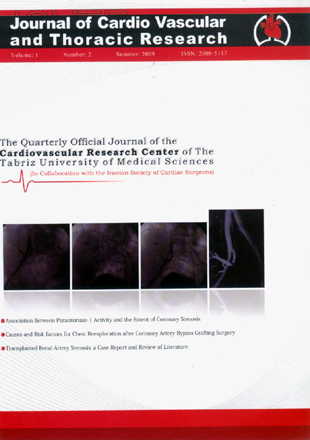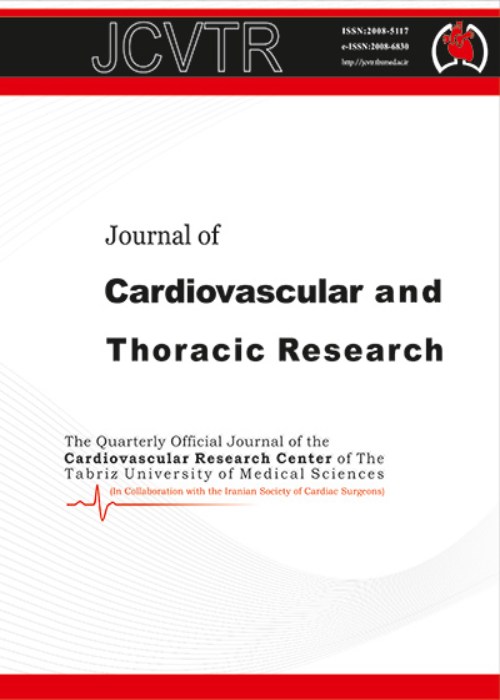فهرست مطالب

Journal of Cardiovascular and Thoracic Research
Volume:1 Issue: 2, May 2009
- 56 صفحه،
- تاریخ انتشار: 1388/06/20
- تعداد عناوین: 10
-
-
Page 1BackgroundParaoxonase (PON1) can prevent oxidized low-den sity lipoprotein formation and development of atherosclerotic lesions. However, studies on the association between PON1 activity and the extent of coronary stenosis and underlying mechanism(s) are limited. In this study, the relationship between paraoxonase and arylesterase activities of PON1 with extent of coronary stenosis together with determination of PON1 phenotypes in the studied patients have been investigated.MethodsParaoxonase and arylesterase activities were measured in 61 patients with coronary stenosis of <50% and 63 patients with coronary stenosis of >70%. Individual human serum phenotyping for the PON1 Q192R polymorphism was achieved through dividing the paraoxonase activity in the presence of 1M NaCl by arylesterase activity.ResultsPatients with stenosis of <50% had significantly higher PON1 activity (p<0.05) and HDL-Cholesterol (p<0.03) compared to those with stenosis of >70%. No significant difference (p>0.05) was observed in the phenotype distribution of males and females.ConclusionAccording to the current study, there are significant differences in paraoxonase and arylesterase activities and also HDL-C levels between patients with coronary stenosis of <50% and those with coronary stenosis of >70%. Therefore, this study provides further support for the important role of paraoxonase activity in coronary atherosclerosis.Keywords: Arylesterase, Coronary artery disease, High, density lipoprotein, Paraoxonase, Stenosis
-
Page 9BackgroundTo make a review of the immediate results of coarctation of the aorta (CoAo) operation, between March 1993 and October 2003 at Madani Heart Center, Tabriz-Iran.MethodsThe following data were investigated: age at the time of surgery, gender, symptoms, clinical and paraclinical findings, associated cardiac lesions, and type of surgical technique, and immediate surgical outcome, particularly focusing on the presence of hypertension.ResultsFifty three patients underwent surgical repair of CoAo. Enrolled patients had an age between 12 months to 49 years (mean 17 years), and 30 (56.6%) were male. Twenty five (47%) patients were asymptomatic. The most common presenting symptoms were palpitation (45%) and dyspnea on exertion / early fatigue (41%). The most common signs were a systolic murmur (96%), and weak lower limb pulses (86%). In electrocardiogram, 96% had signs of LV hypertrophy. The chest-X-ray was normal in only 54%. The location of coarctation was post-ductal in 78% and pre-ductal in the rest. The associated defects were present in 30 (56.6%) patients, most common being patent ductus arteriosus (26.4%) and aortic valve disease (22.4%). Among the various surgical techniques employed end-to-end anastomosis was used in 26 (49%) and Dacron patch aortoplasty in 23 patients (43.3%). During discharge BP was reduced in 75% and unchanged in 25% with respect to preoperative values. Fifteen percent of patients had some complications and one death was observed in the immediate postoperative period.ConclusionThere is a high rate of associated cardiac lesions with CoAo and despite a delayed diagnosis in our region; corrective surgery has a relatively good short term outcome with low morbidity and mortality.Keywords: Coarctation of aorta, Congenital heart disease, Cardiac surgery
-
Page 13BackgroundThis study was performed to detect the severity of proteinuria in children with acyanotic pulmonary hypertension.MethodsTwenty children suffering from pulmonary hypertension due to acyanotic congenital heart disease evaluated for proteinuria. They were divided into two groups of equal less than two and more than two years old, because of the difference in proteinuria ratio in these two groups. Association of proteinuria with age, hematocrit, mean pulmonary arterial pressure and tricuspid regurgitation were evaluated.Resultsalthough there was not any case of proteinuria in nephrotic range but significant proteinuria was observed in 2 out of 11 children aged below 2 year of age, and 3 out of 9 in children above 2 years old. However there was no relationship between age, mean pulmonary arterial pressure, hemoglobin, hematocrit, tricuspid regurgitation and proteinuria. There was not any relationship between proteinuria and the severity of pulmonary artery pressure, tricuspid regurgitation, age and hematocrit in this group of children.ConclusionSignificant proteinuria in children with acyanotic congenital heart disease was present in 25% of cases (5 out of 20). Nephrotic syndrome is uncommom in children with acyanotic pulmonary hypertension congenital heart disease.Keywords: Non cyanotic, Pulmonary hypertension, Proteinuria, Congenital heart disease
-
Page 19BackgroundTo determine causes and risk factors for chest reexploration after coronary artery bypass grafting surgery (CABG).MethodsIn a retrospective study, the medical records of 105 patients that had chest reexploration after CABG surgery from 2004 to 2006 in MadaniHeart hospital were assessed.Frequency of reexploration was 105/1904 (5.5%). In addition, the records of 195 patients without chest reexploration that randomly selected from 1799 patients, were assessed. The medical records of patients were studied regarding demographic characteristics, causes and some risk factors of chest reexploration. Data analysis was conducted by SPSS software using descriptive and inferential statistics.ResultsThe findings indicated that most frequent causes for chest reexploration were bleeding (36.2%) and cardiac tamponade (30.5%). In addition, risk factors for chest reexploration were weight and body mass index (BMI) of patient, preoperative PT value, and preoperative use of Plavix.ConclusionReexploration rate in this study was close to other studies results.Keywords: Reexploration, Coronary artery bypass grafting surgery, Risk factors
-
Page 25BackgroundPsychological problems like as anxiety in patients who are candidate for coronary artery bypass graft (CABGs) may increase mortality and morbidity. The effect of reassurance and preoperative information in decreasing of anxiety is uncertain. This study designed to address the effect of preoperative information and reassurance in decreasing of anxiety of patients who are candidate for CABGs.MethodsWith experimental study and randomize sampling 85 (55male and 30 female) of 238 patients who were candidate for CABGs included and completed spilberger anxiety test on the day of admission. Preoperative information and reassurance done and test completed again on the day before surgery.ResultsMean number of anxiety score in patients with mild anxiety disorder (21 patients) were 34± 4.2 before and 39±5.8 after intervention. In patients with moderate anxiety disorder (39 patients) the number decreased from 52.61±3.8 to 50.76±56. Twenty five patients had severe anxiety disorder before with number of 63.88±2.8 which decreased to 53.88±7.6. All of differences were significant statistically.ConclusionIn patients with mild anxiety preoperative information and reassurance resulted in increasing of anxiety but in patients with moderate or severe anxiety disorder, anxiety level decreased significantly.Keywords: Preoperative information, Reassurance, Anxiety, Spilberger test
-
Page 29BackgroundThe operation for atrial septal defect (ASD) is considered a low risk procedure; the cosmetic result has become an important feature. For this reason the anterolateral thoracotomy is frequently used for closure of ASD. However, difficulty in aortic and caval cannulations to establish cardiopulmonary by pass (CPB) makes it rather awkward for some surgeons.MethodsWe reviewed the short term results of a consecutive series of 17 patients in whom the atrial septal defect was closed through a right anterolateral thoracotomy.ResultsThe average cardiopulmonary bypass time was 36 minutes (range 22 to 53 minutes), with mean aortic cross clamp time of 21minutes (range 12 to 44 minutes). There was no preoperative or late mortality. The majority of patients are pleased with their cosmetic results. There were no other late complications. The mean age at operation was 27 years (range 4 to 53 years), and the mean body weight was 51 kg(range 14 to 155 kg). Al the repaired defects were secondum type ASD.ConclusionAtrial septal defect can be safely repaired through a right anterior thoracotomy approach,with cosmetic results of avoiding median sternotomy.Keywords: Atrial Septal Defect, Right Anterolateral Thoracotomy, Open Heart Surgery
-
Page 33Coronary artery disease (CAD) is a leading cause of mortality, morbidity, and disability in Iranian population. In this study, the association between parity and the presence of CAD in women more than 50 years old age have been investigated in case (100 female patients with documented angiography-defined CAD) and control (320 female subjects with normal echocardiogram) group. Logistic regression analysis revealed that number of pregnancies and hysterectomy with ovarectomy was independent risk factors associated with CAD in this study.Keywords: Fertility, Coronary artery disease, Women
-
Page 37Pulmonary arteriovenous malformation (PAVM) is an abnormal communication between the pulmonary artery and the pulmonary vein. PAVMs are usually congenital in origin. In this study we reported a 32-year-old woman that was referred to the clinic with the chief complain of frequently coughs and hemoptysis for three months. Also, her past medical history revealed that she had a thoracotomy and decortication of the right lung due to clotted hemothorax, about 12 years ago while she had a term pregnancy. CT angiography and spiral CT-scan demonstrated cystic-masses in the right hemithorax. These masses were enhanced like pulmonary vessels and had feeding artery and evacuator vein. So, three PAVMs were diagnosed in the right lung. The patient underwent right postrolateral thoracotomy. Two of the PAVMs were in the lower lobe which treated by resection but the one in the middle lobe was completely intraparenchymal and it could not be localized during the surgery so the lobectomy of the right middle lobe was performed.Keywords: Pulmonary Arterio, Venous Malformation, Pulmonary Arterio, Venous Fistulas, Thoracotomy Lobectomy
-
Page 41We describe 6 cases of chronic thromboembolic pulmonary hypertension, who underwent pulmanry thromboendarterectomy in our center. Transthoracic and transesophageal echocardiography provided valuable data on surgical accessibility of thrombus, its extension, chronicity and hemodynamic consequences on right ventricular function. transesophageal echocardiography as a rapid, bedside and easily available method has been a useful guide for diagnosis and guiding the treatment for these patientsKeywords: Thromboendarterectomy, Transesophageal echocardiography, Pulmonary Hypertension
-
Page 45Transplant renal artery stenosis (TRAS) is a relatively frequent, potentially curable cause of refractory hypertension and allograft dysfunction and usually becomes apparent between 3 months and 2 years after renal transplantation. Depending on the hemodynamic significance of stenosis it can be treated conservatively or by revascularization. Here we describe a case of TRAS which was treated successfully with angioplasty and stenting and then we will have a review on its etiology, natural history, diagnosis and therapy.Keywords: Transplanted Renal Artery, Stenting, Angioplasty


